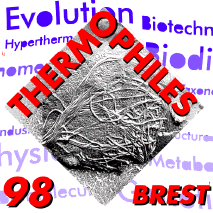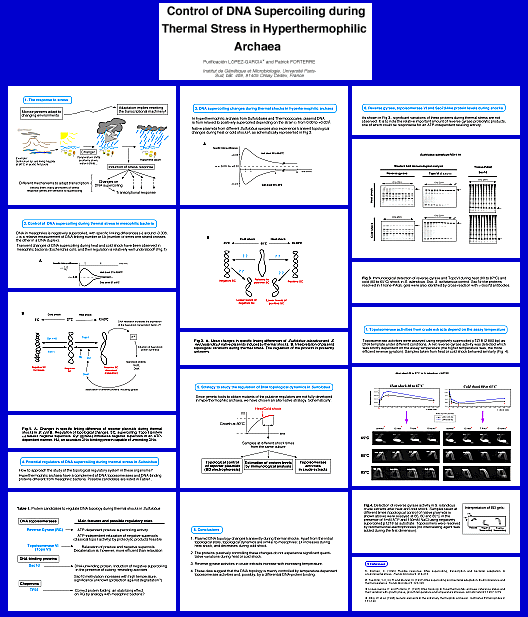Control of DNA Supercoiling during
Thermal Stress in Hyperthermophilic Archaea
Purificación LÓPEZ-GARCÍA* and
Patrick FORTERRE
Institut de Génétique et Microbiologie,
Université Paris-Sud, bât. 409, 91405 Orsay
Cedex, France
Environmental changes such as temperature or osmolarity
shifts can affect DNA supercoiling. Many promoters,
specially those of genes coding for proteins involved in the
stress response, are indeed sensitive to DNA supercoiling.
Accordingly, variations in DNA conformation have been
suggested to trigger the stress response by switching on
some genes while silencing others.
In mesophilic bacteria, where DNA is negatively
supercoiled, heat or cold shocks are accompanied by
transient modifications of DNA topology. Gyrase, introducing
negative supercoils, the DNA-binding protein HU and the
chaperone DnaK regulate these changes. In hyperthermophilic
archaea, where plasmid DNA is found from relaxed to
positively supercoiled, important transient topological
changes are observed as well (1). Plasmids from different
strains of Sulfolobales (kingdom Crenarchaeota) and
Thermococcales (Euryarchaota) exhibit a sharp linking number
(Lk) increase during heat shock (80 to 85 or 92°C) and
a decrease during cold shock (80 to 65°C). A subsequent
recovery of values closer to the initial state is observed.
We have initiated a study aiming to identify the
regulators of DNA topology involved in the thermal stress
response in these organisms. In general, DNA-topoisomerases
and small DNA-binding proteins (histones and histone-like)
are the main intracellular components of the machinery
controlling DNA conformation. In Sulfolobus strains, the
candidate proteins to regulate DNA topology during thermal
shocks are essentially reverse gyrase, a
hyperthermophile-specific enzyme introducing positive
supercoils in DNA, the relaxing Topoisomerase VI, and Sso7d,
a small and abundant DNA-binding protein which unwinds DNA.
Immunological analysis does not reveal quantitative changes
of these proteins during shocks. Analysis of crude extract
activities rather suggests that DNA topological dynamics
during heat and cold shock is controlled by specific global
topoisomerase activities and DNA-protein binding at
different temperatures.
(1) López-García, P., and Forterre, P.
(1997) Mol. Microbiol., 23, 1267-1279.
Keywords: DNA Supercoiling, Hyperthermophilic Archaea,
Thermal stress
|

To
see an overview of the poster follow this link















